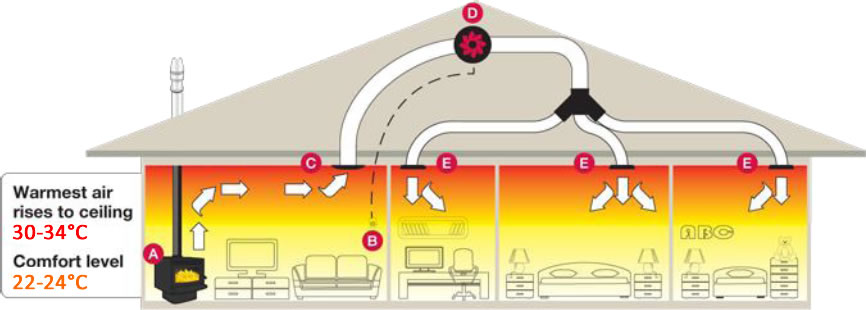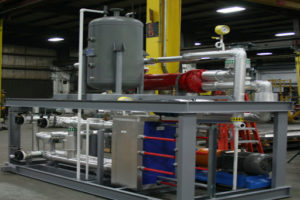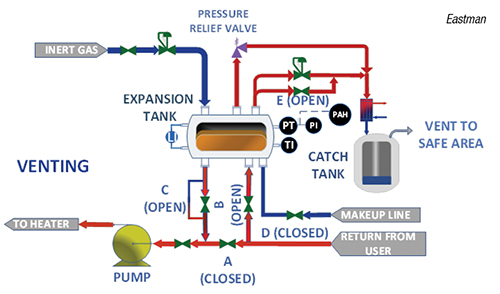Emerging Innovations Shaping the Future of DVS Heat Transfer Systems
Wiki Article
A Comprehensive Overview to Selecting the Right Heat Transfer Systems for Your Requirements
Choosing the suitable Heat transfer system is necessary for functional performance. Different systems accommodate different demands, affected by elements such as temperature array and liquid kind. Comprehending the principles behind Heat transfer, such as radiation, conduction, and convection, is crucial. In addition, reviewing power sources and upkeep practices can affect long-lasting efficiency. A closer evaluation of these factors to consider discloses exactly how to customize a system to certain requirements. What should one prioritize in this complex decision-making process?Comprehending Heat Transfer: Key Concepts and Principles
Although Heat transfer might feel like an uncomplicated principle, it incorporates a variety of principles that are essential for reliable system layout. Comprehending these concepts is crucial for engineers and designers who intend to optimize thermal performance in different applications. Transmission, for example, entails the transfer of Heat via strong products, while convection refers to the movement of Heat within liquids. Radiation, another crucial concept, explains exactly how Heat can be moved through electro-magnetic waves. Each of these devices plays an important function in determining how energy relocates within a system. By extensively realizing these principles, specialists can make educated choices, guaranteeing that Heat transfer systems run effectively and meet the specific demands of their applications
Types of Heat Transfer Solutions: An Introduction
Comprehending the concepts of Heat transfer prepares for discovering the various kinds of Heat transfer systems offered. Heat transfer systems can be classified mainly into three types: transmission, radiation, and convection. Transmission involves Heat transfer through strong products, relying upon direct call in between particles. Convection, on the various other hand, occurs in liquids (gases and fluids) where the motion of the fluid itself helps with Heat transfer. Radiation includes the transfer of Heat through electro-magnetic waves and does not need a medium, allowing it to happen in a vacuum. Each sort of system has distinct qualities and applications, making it important for people and companies to meticulously evaluate their specific requirements when picking the most suitable Heat transfer remedy.Applications of Heat Transfer Equipments in Various Industries
Heat transfer systems play an essential role throughout numerous sectors, affecting effectiveness and item quality. In industrial manufacturing processes, they facilitate precise temperature control, while in food and beverage handling, they guarantee security and conservation. Additionally, cooling and heating and environment control systems count heavily on efficient Heat transfer to preserve comfy environments.Industrial Production Processes

Numerous industrial production procedures depend greatly on reliable Heat transfer systems to make best use of performance and enhance product top quality. In fields such as metalworking, Heat exchangers play an important function in preserving excellent temperature levels during welding, spreading, and creating. These systems ensure consistent Heat circulation, which is essential for accomplishing preferred product buildings. Similarly, in the chemical manufacturing market, Heat transfer systems promote accurate temperature control during reactions, impacting return and security. In fabric production, reliable Heat monitoring is vital for coloring and finishing procedures, affecting color consistency and material top quality. By choosing appropriate Heat transfer modern technologies, manufacturers can improve power efficiency and reduce functional expenses, ultimately bring about a much more affordable and sustainable manufacturing atmosphere.
Food and Drink Processing
Reliable Heat transfer systems are similarly important in the food and drink handling industry, where maintaining excellent temperatures is vital for food safety and security and quality. These systems play a crucial function in procedures such as pasteurization, sanitation, and food preparation, making sure that products are secure for intake and keep their dietary value. Heat exchangers, for circumstances, efficiently move Heat in between liquids, enhancing power usage while reducing temperature level fluctuations. In addition, refrigeration systems are fundamental for protecting subject to spoiling products and prolonging life span. The choice of Heat transfer technology straight influences operational efficiency and product honesty, making it essential for food and beverage makers to choose the appropriate systems tailored to their particular processing requirements. This cautious selection eventually adds to customer satisfaction and food safety and security.
Heating And Cooling and Environment Control
While numerous sectors depend on Heat transfer systems for efficiency, A/C (Heating, Air Flow, why not check here and Air Conditioning) plays an important function in maintaining indoor environment control throughout different setups. These systems make use of Heat transfer principles to manage moisture, air, and temperature high quality, guaranteeing convenience and safety and security in household, commercial, and industrial settings. Correctly created cooling and heating systems enhance energy effectiveness, minimize functional expenses, and decrease ecological impact. In commercial buildings, for example, reliable environment control contributes to worker efficiency and consumer fulfillment. In commercial applications, HVAC systems aid maintain suitable conditions for equipment procedure and product conservation. Choosing the ideal Heat transfer system is vital for meeting certain climate control requirements and achieving overall system performance.Assessing Energy Sources for Heat Transfer Solutions
In reviewing energy sources for Heat transfer systems, a comparison of renewable energy options and fossil fuel considerations is necessary. Eco-friendly resources, such as solar and wind, deal sustainable alternatives that can reduce environmental impact. Conversely, fossil fuels remain prevalent as a result of their well-known framework and energy density, triggering a mindful analysis of both choices.Renewable Resource Options

Fossil Gas Factors To Consider
Reviewing nonrenewable fuel source considerations is important for the efficiency and sustainability of Heat transfer systems. Fossil gas, such as all-natural gas, oil, and coal, are standard energy resources that supply significant Heat outcome, making them popular options for industrial and property applications. Nevertheless, their ecological effect, consisting of greenhouse gas exhausts and source deficiency, increases issues. When choosing a heat transfer system, it is vital to assess the schedule, price, and regulative factors linked with these gas. Furthermore, the performance of nonrenewable fuel source systems need to be considered, as greater effectiveness can minimize some environmental drawbacks. Eventually, a balanced strategy considering efficiency and sustainability can guide decision-makers toward the most appropriate Heat transfer remedy for their particular requirements.Variables to Consider When Choosing a Warmth Transfer System
Selecting a proper Heat transfer system needs careful consideration of various elements that can significantly affect effectiveness and efficiency. One crucial variable is the operating temperature level range, which determines the products and style suitable for the application. Furthermore, the kind of liquid used in the system-- whether gas or fluid-- impacts Heat transfer performance and compatibility. The system's dimension and ability have to straighten with the specific demands of the procedure to stay clear of inefficiencies. Energy resource schedule is also important, affecting operating expense and sustainability. The installment setting, consisting of area constraints and access for maintenance, plays a considerable duty in system selection. Regulative compliance and safety and security requirements should be considered to assure the system satisfies all lawful needs.Upkeep and Performance Optimization for Heat Transfer Equipments
Preserving Heat transfer systems is crucial for making certain optimal effectiveness and longevity. Regular upkeep activities, such as cleansing Heat exchangers and evaluating insulation, assistance avoid efficiency losses because of fouling and thermal bridging. Additionally, checking system parameters, consisting of stress and temperature level, enables early detection of abnormalities, lessening downtime and pricey fixings. Applying a preventative upkeep schedule can maximize performance and extend the life-span of components. In addition, upgrading to sophisticated control systems can enhance operational efficiency by adapting to differing problems and loads. By focusing on upkeep and efficiency optimization, operators can achieve decreased energy intake, lower operational costs, and improved general system integrity, ultimately resulting in much better source utilization and a more lasting procedure.Future Fads in Heat Transfer Technologies
As sectors increasingly focus on sustainability and energy efficiency, future fads in Heat transfer technologies are established to go through considerable changes. Advancements such as advanced products, including carbon nanotubes and nanofluids, promise boosted thermal conductivity and performance. In addition, the combination of renewable resource resources right into Heat transfer systems is gaining momentum, advertising eco-friendly solutions. Smart technologies, consisting of IoT sensors, are expected to more tips here revolutionize monitoring and control, enabling real-time data evaluation for enhanced performance. In addition, the growth of portable and modular systems will promote much easier installation and maintenance, dealing with diverse applications. These advancements suggest a change towards even more sustainable, efficient, and versatile Heat transfer remedies, aligning with international energy objectives and environmental requirements.
Frequently Asked Concerns
What Are the Ecological Influences of Heat Transfer Equipments?
The environmental influences of Heat transfer systems can include greenhouse gas exhausts, energy consumption, and possible thermal contamination. In addition, improper disposal of products and ineffectiveness can contribute to resource deficiency and environment interruption.How Do I Calculate the Cost-Effectiveness of a Heat Transfer System?
To calculate the cost-effectiveness of a warm transfer system, one must assess preliminary costs, functional expenditures, maintenance needs, and power efficiency, comparing these aspects versus the anticipated lifespan and efficiency of the system.Can Heat Transfer Solution Be Made Use Of in Residential Setups?
Heat transfer systems can certainly be made use of in property setups. They give effective home heating and cooling solutions, making homes much more comfortable while potentially reducing energy prices. Their flexibility enables different applications in property environments.What Safety Regulations Put On Heat Transfer Solutions?
Safety policies for Heat transfer systems typically consist of standards on maintenance, installment, and procedure. Compliance with regional building regulations, supplier requirements, and market requirements is important to ensure reliable and secure system efficiency in various applications.Exactly How Do Different Materials Affect Heat Transfer Performance?

Conduction, for instance, involves the transfer of Heat via strong products, while convection refers to the activity of Heat within liquids. Recognizing the principles of Heat transfer lays the groundwork for exploring the various types of Heat transfer systems available. Heat exchangers, for circumstances, effectively transfer Heat between fluids, enhancing energy use while decreasing temperature variations. In assessing energy sources for Heat transfer systems, a contrast of renewable power alternatives and fossil fuel considerations is essential. Steels, such as copper and aluminum, conduct Heat efficiently, this post whereas insulators like rubber and glass reduce down Heat circulation.
Report this wiki page